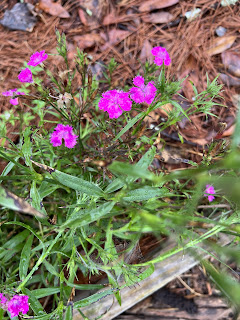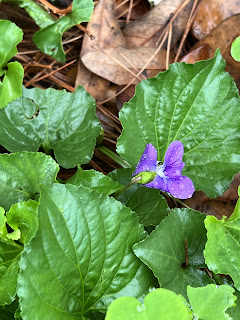 |
| —1– |
 |
| —2— (the red one) |
 |
| —3— |
 |
| —4— |
 |
| —5— |
 |
| —6— |
 |
| —7— |
 |
| —8— |
 |
| —9– |
 |
| —10— |
 |
| —11— |
 |
| —12— |
 |
| —13— |
 |
| —14— |
 |
| —15— |
Answers:
1. Yarrow (Achillea millefolium). Native perennial medicinal. Evergreen in the North Florida area. Attracts butterflies, bees, and other insects. Spreads readily.
2. Blanket Flower (Gaillardia aristata). Short-lived native perennial. Attractive to a diversity of bees, larval host for some moths and butterflies. Reseeds prolifically. Long blooming period from early to late summer.
3. Dianthus aka Pinks or Carnations (Dianthus spp.). Perennial (some varieties) which blooms spring to early summer. Fragrant flowers attract bees and butterflies.
4. Golden Alexanders (Zizia Aurea) Native perennial in the carrot family. Larval host for Black Swallowtail butterflies and attracts a variety of other beneficial insects.
5. Crimson Clover (Trifolium incarnatum) Reseeding legume cover crop which attracts pollinators and fixes nitrogen, Root zone is earthworm heaven. Also good for preventing erosion and suppressing weeds.
6. Collards (Brassica oleracea) Cold weather vegetable. If not harvested and removed, will bloom in spring and attract bees and butterflies. After blooming, stalks can be cut to the ground to get fresh new growth.
7. Mustard (Brassica juncea, B. rapa) Cold weather vegetable and/or cover crop. Suppresses weeds and produces compounds which biofumigate the soil to kill nematodes and pathogenic fungi. Produces organic matter easily incorporated into the soil. When allowed to bloom, attracts bees and other beneficial insects.
8. Purple Coneflower (Echinacea purpurea) Native perennial medicinal. Many types of bees regularly visit echinacea as well as swallowtail butterflies. More useful than many other pollinator plants for producing nectar in the heat of the day.
9. Sugar Snap Peas (Pisum sativum) Cool weather vegetable with edible pods.
10. Larkspur (Delphinium consolida) This is a reseeding annual. While there are a number of native larkspurs, I do not believe this is one of them. Larkspur is attractive to pollinators but the configuration of the flowers makes it difficult for any but long-tongued bees and hummingbirds to reach the nectar. All parts of larkspur are poisonous to humans and animals. It is highly palatable to cows and other large animals. Even contact with the skin will cause irritation. There is no known treatment for larkspur poisoning.
11. Florida Betony (Stachys floridana) Considered to be an annoying perennial weed, this native edible plant produces tubers which taste like mild radishes. Often called Rattlesnake weed because the tubers resemble rattlesnake rattles. Other parts of the plant are also edible, and the flowers attract bees and butterflies.
12. Dahlia (Dahlia coccinea) The tubers and flowers of this tender perennial are edible and the flowers are very popular with pollinators.
13. Alyssum (Lobularia maritima) This cool weather annual provides late winter and early spring forage for bees and other pollinators with flowers that smell like honey.
14. Violet (Viola sororia) The flowers of this native ground cover attract bees and other flying pollinators.
15. Buckwheat (Fagopyrum vulgare) One of our favorite cover crops produces flowers within 21 days of planting. While it does not produce a large amount of biomass, it is valuable for planting in narrow windows between crops to feed micro-organisms, suppress weeds and retain moisture. It is particularly helpful to plant it among or alongside spring and summer crops. Its flowers attract many types of pollinators and beneficial insects. Two small organic vegetable farmers in Live Oak participated in a study with the University of Florida and Southern Sustainable Agriculture Research & Education (SSARE) to evaluate cover crops as trap plants in an effort to reduce chemical pest control. Sunflowers acted as trap plants for stinkbugs, particularly leaf-footed bugs, keeping them away from tomatoes and peppers. But buckwheat was the star, as researchers counted over 60 families of beneficial and predatory insects on the buckwheat. SARE reports, “In one example, researchers collected nymphs and adults of four species of stinkbug and found that all of them were parasitized by an orange tachinid fly, which is attracted to the blooming stage of buckwheat.”
Fabulous amount of information that is immediately useful in the garden. Thanks, Janis!
ReplyDelete